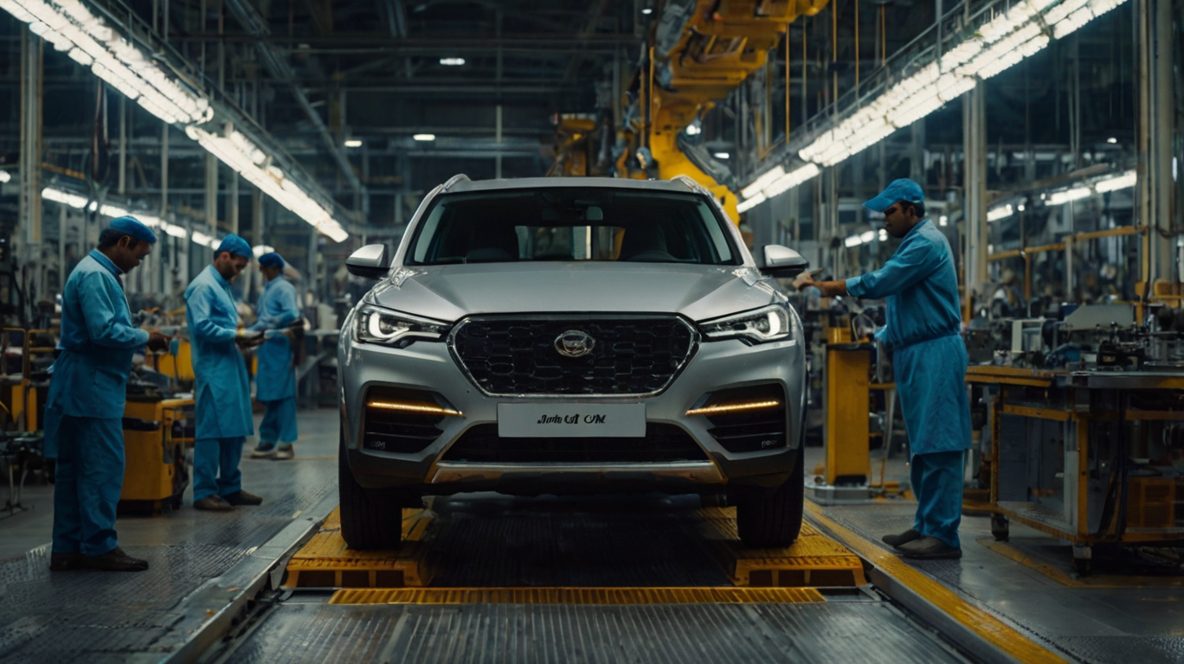World Buying ‘Made in India,’ but Not Indian: The Tale of India’s Car Export Story
India’s automotive industry has long been a powerhouse in domestic vehicle production, but the story on the global export front is far more nuanced. While the world increasingly buys cars “Made in India”, the majority of those vehicles are not from homegrown brands. Instead, it is multinational manufacturers such as Maruti Suzuki—an Indo-Japanese collaboration—that dominate the export numbers, leaving native giants like Tata Motors and Mahindra & Mahindra playing catch-up in international markets.
Recent developments highlight both the promise and the disparity in India’s global automotive footprint.
Recent Export Milestones
Three significant events over the past month demonstrate India’s growing relevance in global car exports:
Maruti Suzuki eVitara Launch (August 26) – The company announced its first born-electric vehicle, the eVitara, will be exported to over 100 countries in addition to being sold domestically. This milestone underscores Maruti Suzuki’s ability to integrate Indian manufacturing with international demand.
Tata Motors Re-Entry into South Africa (August 20) – Tata, India’s iconic homegrown automaker, made a strategic comeback to Africa’s largest car market with four new models. South Africa has historically been a gateway to the broader African continent, and Tata’s re-entry signals an intentional push into high-volume, strategic markets.
Mahindra & Mahindra Concept SUVs (August 15) – The automaker showcased four visionary concept SUVs—Vision.T, Vision.S, Vision.SXT, and Vision.X—designed for both right-hand drive (RHD) and left-hand drive (LHD) markets. This demonstrates Mahindra’s long-term intent to design globally adaptable vehicles, though the path to widespread export is still developing.
Export Numbers: A Tale of Two Approaches
While Maruti Suzuki thrives on exports, Indian homegrown brands have modest footprints:
Maruti Suzuki PV exports grew 17.6% in FY25, from 2,80,712 units to 3,30,081 units.
Tata Motors and Mahindra combined accounted for only 2.4% of India’s PV exports—a total of 18,590 units (Mahindra: 15,743 units, Tata: 2,847 units).
Even with Mahindra now India’s second-largest carmaker, its global rank on the export front is eighth, while Tata lags at 11th.
Automotive analysts consistently point out that brand-building remains a crucial gap for homegrown manufacturers.
The Global Perception Challenge
A former Tata Motors CXO highlighted the core issue:
“Unlike established international players from Japan and Korea, Indian brands like Tata and Mahindra are still in the process of building their global reputation. In many developed markets, car buyers are highly brand-conscious and may be hesitant to purchase a vehicle from a less-known manufacturer.”
This insight points to a brand credibility gap. While India produces vehicles at scale, the global market often equates quality and reliability with familiar foreign brands.
Export Strategies: Maruti vs. Tata and Mahindra
Maruti Suzuki’s export success demonstrates a strategic advantage:
The company leverages its strong domestic R&D, cost-effective manufacturing, and established brand name, which resonates abroad through the “Made in India” label paired with Japanese engineering standards.
Its vehicles, including the upcoming eVitara EV, are designed for global compliance, meeting stringent international emission and safety standards.
By contrast, Tata and Mahindra are gradually building export readiness:
Historically, exports were limited to low-investment geographies such as Nepal, Bangladesh, Bhutan, Sri Lanka, and parts of Africa, where regulatory expectations were less stringent.
As Indian consumer preferences evolved to match global standards, Tata and Mahindra have upgraded product quality and design, enabling them to target more mature markets.
Gaurav Vangaal, associate director at S&P Global Mobility, noted:
“Exporting isn’t just about shipping cars; it requires a strategic plan and a product tailored for international markets. Over the past five years, Indian consumer preferences have matured, and both Tata and Mahindra have responded well, delivering products that meet these elevated expectations.”
Strategic Market Expansion
Both Tata and Mahindra are actively exploring new export territories:
Africa: Tata’s re-entry into South Africa is significant given its position as the continent’s largest automotive market. Mahindra also maintains a presence in African countries but is looking to expand its reach into more regulated, high-volume markets.
Latin America, Europe, and GCC: These regions are being evaluated for potential exports, reflecting an ambitious global strategy.
UK-India Trade Discussions: Ongoing bilateral trade agreements, particularly with the UK, present opportunities for homegrown brands to compete in developed markets.
Electrification: A Game-Changer
Electrification is seen as a major opportunity for Indian OEMs:
Mahindra’s Vision concept SUVs and Tata’s upcoming Avinya EV range are positioned to meet rising global demand for electric vehicles.
Tata benefits from the Jaguar Land Rover (JLR) acquisition, providing instant access to premium markets without relying solely on its own brand.
Analysts suggest that electrification offers homegrown brands a unique chance to leapfrog legacy brand perceptions in developed markets, offering technologically advanced, sustainable vehicles that resonate with environmentally conscious consumers.
Challenges in Branding and Perception
Despite these opportunities, several hurdles remain:
Brand Recognition: International consumers still associate reliability with Japanese, Korean, and European brands, making it harder for Tata and Mahindra to establish trust.
Regulatory Compliance: Developed markets impose stringent emission, safety, and quality standards. Exporting to these regions requires substantial R&D investment and compliance infrastructure.
Consumer Preferences: Buyers in Europe, North America, and Australia tend to prioritize design, technology, and after-sales service, areas where Indian brands are still building global capabilities.
The Role of Trade Agreements
Bilateral trade agreements are key enablers for Indian car exports:
Tariff Reductions: Agreements with countries like the UK can lower import duties, making Indian vehicles more price-competitive.
Market Access: Preferential trade arrangements can facilitate easier entry into developed markets, mitigating barriers to initial penetration.
Policy Support: Government-led incentives for electric vehicles and exports further enhance global competitiveness.
These developments indicate a strategic alignment between public policy and corporate ambition, providing Indian brands a stronger footing for global expansion.
Export vs. Domestic Priorities
A historical challenge has been the focus on domestic sales:
Tata and Mahindra have traditionally prioritized the Indian market, which is large, diverse, and profitable.
Exports were often secondary, with vehicles modified minimally for foreign markets.
The recent push signals a shift in mindset—a recognition that India’s automotive engineering and manufacturing capabilities can meet global demand, particularly as EV adoption accelerates worldwide.
Case Study: Maruti Suzuki’s Export Play
Maruti’s export model illustrates how India can be a manufacturing hub for global brands:
The company leverages local cost advantages while adhering to international standards.
Its eVitara EV exemplifies a product built for both domestic and global consumers, satisfying emission norms, safety regulations, and aesthetic expectations.
Maruti’s approach underscores that Indian manufacturing is world-class, but the “Indian” branding is less relevant internationally when the brand has foreign ties.
Lessons for Homegrown Brands
Tata and Mahindra are learning from the Maruti template while pursuing unique strategies:
Product Differentiation: Focus on EVs and SUVs, where global demand is rising and Indian brands can compete on value-for-money and innovation.
Strategic Partnerships: Tata’s JLR acquisition offers an immediate entry into premium markets without building a new brand from scratch.
Market-Specific Vehicles: Mahindra’s Vision SUVs are being designed for RHD and LHD markets, increasing flexibility for global deployment.
Brand Building: Continuous efforts in marketing, international showcases, and quality assurance are essential to gain consumer trust overseas.
The Bigger Picture: India as a Global Manufacturing Hub
While Indian homegrown brands lag in exports, the “Made in India” label is increasingly respected worldwide:
Multinational automakers rely on India for cost-effective manufacturing.
Global demand for affordable, high-quality vehicles positions India as a strategic production center.
This duality—India as a manufacturing hub vs. homegrown brands lagging in global recognition—defines the current export landscape.
Future Outlook
The path forward for Tata and Mahindra includes:
Scaling EV exports as global markets shift toward electric mobility.
Targeting niche and emerging markets for initial international recognition.
Gradual entry into developed markets, supported by trade agreements, brand-building, and technological innovation.
Analysts emphasize that the next five to ten years will be pivotal. As Indian brands expand globally, their success will depend on product quality, design innovation, brand perception, and strategic partnerships.
Conclusion
India’s automotive export story is one of contrasts. On the one hand, international consumers increasingly buy cars made in India, trusting the country’s manufacturing excellence. On the other hand, homegrown brands are still building recognition, trust, and brand equity in global markets.
Maruti Suzuki exemplifies export success, blending Indian production efficiency with Japanese engineering credibility. Tata Motors and Mahindra are on the cusp of global expansion, leveraging electrification, strategic acquisitions, and regional trade agreements to slowly establish a global footprint.
In short, the world is buying “Made in India”, but it is only a matter of time before homegrown brands make their mark, competing not just as manufacturers, but as global automotive leaders in their own right.
Stay updated with reliable news:
Sports: Sport Flash HQ
Business: Biz Rush
Weather: The Climate Post
Travel: Neon Report
US Local: 24 Hour Bulletin
India Finance: The Lucky Ledger
General: The Chrono Post










